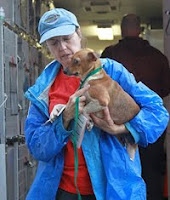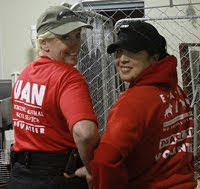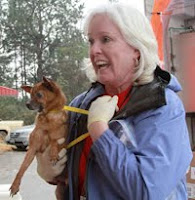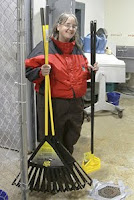Beneath sore backs and aching arms, exhilaration
March 10th, 2010
Submitted by EARS volunteer Marcia Goodman of Cromwell, Connecticut
What’s it like to be a volunteer during the rescue phase of an animal rescue? Ask four EARS volunteers who joined the sheriff and HSUS yesterday morning to seize the animals at Raven’s Hope.
We arrived at the temporary emergency shelter yesterday morning at 8:30 in order to meet the sheriff and The HSUS bus that was to follow the sheriff to the property to pick up the dogs. The sheriff has been terrific to work with – forthcoming and very considerate. He explained the history of this case and gave all of us a briefing on the day’s plan for him first to serve the warrant and remove the dogs from the property, and then call in UAN, HSUS and Mississippi Animal Rescue League staff and volunteers, who were waiting on the road near the property.
The four UAN volunteers who were part of the seizure of the dogs were Judi Burnett (right), Ethel Spence and Monica Ailey from Texas (below), and Angela Shields from Virginia (above). Late in the day, after they returned from the field, I interviewed Judi, Ethel and Monica.
These volunteers described a situation that was horrifying. When they first arrived on the property, they saw what looked like a junkyard, with feces everywhere and dogs running free. When The HSUS truck arrived and the ramp was lowered, several dogs walked up the ramp as if to say, “Get me out of here.” Maybe this would be a quick and easy rescue, the volunteers thought; however, the day turned out to be anything but quick or easy.
When the volunteers went to the pens, they found the carcasses of two dogs, and then found a dog eating a rat. Inside the house, the floor was covered with feces and junk about four inches high. The floor was not visible, and neither were the tops of tables; everything was covered with feces, empty cans and other junk. The smell was overwhelming; they all needed respirators.
In the bedroom, 20 dogs and 2 cats were trying to hide and the volunteers lifted the mattress in an effort to find them. The area between the mattress and box springs was covered with roaches. The house also had large rats in it.
In total, there were seven dead dogs on the property. The volunteers told me of a tall pile of towels with a dead dog on top, so matter of factly, as if it were a sculpture.
The sheriff’s office had estimated about 80 to 100 dogs – hard to estimate because so many were running loose. As it turned out, the rescue team brought 165 dogs to the temporary emergency shelter. A few dogs are still on the property; they couldn’t be caught and will hopefully be caught with food traps.
Once the dogs were captured, most were friendly. Many sought affection from the volunteers. It was immediately obvious to the volunteers that most dogs needed some veterinary care. Many of the dogs scratch themselves constantly and some have patches of sore, red skin without hair, indicating skin ailments – perhaps sarcoptic mange. Some dogs were dehydrated. Many had lacerations as well as scars from prior lacerations. It was very difficult for the volunteers to see the dogs in this deteriorated condition.
The volunteers arrived back at the shelter after 9 p.m., exhausted and not having eaten since breakfast. Their backs and arms ached because many of the dogs, including large dogs, had resisted a leash, and the volunteers had carried them to the vehicle.
But beneath the sore backs, aching arms and exhaustion was a feeling of exhilaration among these volunteers at having rescued 165 dogs and 2 cats from the life of the pain and suffering that they had endured for so long. The volunteers who remained at the shelter to prepare for the dogs’ arrival shared that feeling, especially as we carried the dogs from the disaster vehicle into the shelter, fed the ravenously hungry dogs, saw them snuggle up with each other in their cozy bedding of nice, soft chips, and watched the veterinarians begin the process of examining and treating the dogs for their illnesses. It was a very difficult day, but it was also a very good day.








